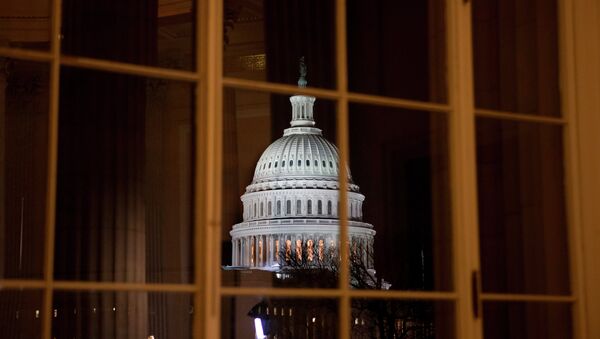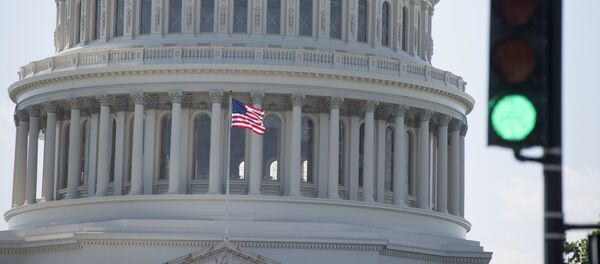The story goes that reporters were told by Senate staffers that they may not film interviews in the hallways unless they get express permission from that specific senator as well as from the Senate Rules Committee (SRC). The earliest reports claimed that the decision was unilaterally made by SRC chair Richard Shelby (R-AL).
ALERT: Reporters at Capitol have been told they are not allow to film interviews with senators in hallways, contrary to years of precedent
— Kasie Hunt (@kasie) June 13, 2017
CONDITIONS for any interview: Previously granted permission from senator AND Rules Committee of Senate
— Kasie Hunt (@kasie) June 13, 2017
WHAT HAPPENED: Reporters were in hallways this morning per usual. Gallery staff were dispatched to issue verbal directive: Stop filming
— Kasie Hunt (@kasie) June 13, 2017
In recent months, the hallways of the Senate have been packed to bursting with journalists looking for statements and scoops. Senior Washington correspondents have claimed that an average day on Capitol Hill in 2017 has seen more reporters than the heights of scandals like Watergate or former US President Bill Clinton's impeachment proceedings.
Sources at the SRC have contradicted themselves many times over as to the maybe-maybe not rule change.
Woman who answered phone at senate rules committee just told me they have no statement and are ‘very confused’ as well.
— Hadas Gold (@Hadas_Gold) June 13, 2017
A spox for Ted Cruz, who is on the Senate Rules Committee tells me of rules change "We were not aware of it until we saw on Twitter"
— Ben Jacobs (@Bencjacobs) June 13, 2017
Just spoke with Senator Shelby. He said he wouldn't move forward on change to press access without consulting me and we must hold him to it
— Amy Klobuchar (@amyklobuchar) June 13, 2017
An hour later, SRC Ranking Member Amy Klobuchar (D-MN) claimed that Shelby told her that he wouldn't limit media access, which suggested that the restrictions were either dropped or they never existed in the first place.
Shelby then issued a statement: "The Rules Committee has made no changes to the existing rules governing press coverage on the Senate side of the Capitol complex. The Committee has been working with the various galleries to ensure compliance with existing rules in an effort to help provide a safe environment for Members of Congress, the press corps, staff, and constituents as they travel from Senate offices to the Capitol. Once again, no additional restrictions have been put in place by the Rules Committee."
However, there is a Senate rule on the books that claims stakeouts and videotaping require permission – it just hasn't been enforced in the past. Further thickening the plot, reports surfaced that the SRC's rule change had been reversed.
Senate Rules Committee says no rules have been changed; technically, they appear correct. Just was not enforced. https://t.co/Y2vz1eUReS pic.twitter.com/E8Yynf5BpF
— Emily Atkin (@emorwee) June 13, 2017
NEW: Senate Rules Committee reverses course on hallway interviews. "You may continue to follow the rules as if it was yesterday."
— Kasie Hunt (@kasie) June 13, 2017
Georgetown Professor of Journalism Chris Chambers speculated that the contradictions and confusions were an intentional deception meant to neuter media response. "Confusing the press is just as effective as having uniformed thugs forcibly detain reporters and destroy their equipment. The key is not let the press do its job," he told Sputnik.
"You saw an analogous situation in Ferguson, Missouri, after the killing of Mike Brown by police, where police would issue vague or conflicting statements on time, place and manner, thus robbing the media of any platform from which to perform its watchdog role. Once in the dark, the government can hide and do whatever it wants, without either prior scrutiny or peeks [into] the process by the press."
Left-wing sources have argued that the GOP instituted the change to prevent journalists from getting details on the health care bill lawmakers are currently working on, as well as to generally further erode democracy and freedom of the press.
Chambers concurred. "I think it's clear from the context and recent developments that the Senate GOP leadership is indeed trying to shield itself from press scrutiny regarding health care of course, and other matters… current protocol [for journalists] is to allow interviews, allow access to senators leaving or going into hearings, et cetera, allow full Q&A and any reasonable amount of video and audio equipment during working hours as long as it doesn't impede Senators' access to their work or constitute harassment or offensive conduct. There's been no such showing by Shelby, so the only reasonable conclusion is that they wish to hide."
In mid-May, the Senate Media Gallery released a letter complaining of the heavy journalist traffic in the halls of the Capitol. "We understand the increased demand for reporting at the Senate," they wrote. "However, we are concerned about everyone's safety. Collectively, the press following senators have become large and aggressive. We are concerned someone may get hurt."
"Under their own determination, Senate officials may act to correct overcrowding situations in the Senate Subway area or in the Ohio Clock Corridor area," the letter added.
Except in times of crisis, according to Chambers, "the outer and hallway areas have traditionally been the quasi public 'space' where senators and the press interact, and indeed senators called upon respond to a State of the Union address typically do so from these hallways… at no time has the press been excluded from areas outside hearing rooms even in the Capitol."
"They are bound by the First Amendment and may only place reasonable time, place or manner restrictions on press access. But to be reasonable, they cannot be arbitrary, as in we just feel like it, and rattling off some mumbo jumbo about 'safety.' There has to be a nexus to something concrete."



